Speech The Development of Hedging Markets in Asia
Thank you for the invitation to speak here today.
My involvement with financial markets gives me a keen appreciation of the importance of regulation, including both the difficulty in getting it right and the damage that can be done when it's not right.
So, I would like to start by talking about the Asian and global financial crises and the policy/regulatory responses intended to reduce the risk and damage of future crises. I will then discuss developments in bond and hedging markets in Asia. And I will conclude with some comments on the Australian experience with financial liberalisation, and the extent to which subsequent regulatory developments may affect the financial liberalisation experience for some emerging economies in the region.
The Asian financial crisis and policy response
The Asian financial crisis in 1997–98 was associated with domestic financial institutions borrowing foreign currency short-term and on-lending in unhedged local currency at longer maturities.[1] The resulting currency crises – including in Thailand, Indonesia and South Korea – led to important changes in exchange rate regimes, with markets playing a greater role in determining exchange rates since that time. As a result of higher exchange rate volatility, both during the crisis and subsequently, market participants and policymakers became keenly aware of the need for better exchange rate risk management.
The Asian financial crisis did not give rise to a globally, or even regionally, coordinated regulatory response to deal with foreign exchange (FX) risk. But it did, of course, give rise to regulatory responses at the national level. Another national response was the accumulation of foreign currency reserves as a means of insuring against any future balance of payments crises. Across the region, this has been augmented with bilateral and multilateral swap lines.
The crisis did give rise to regionally coordinated efforts to redress exchange rate risk by developing bond markets that would allow corporations to borrow directly from markets at longer maturities and, importantly, in local currency. These efforts include the Asian Bond Fund initiatives by the EMEAP central banks and the Asian Bond Markets Initiative, established by the Asian Development Bank and ASEAN+3 nations.[2]
These initiatives have included various measures to encourage broader participation in local currency bond markets, including by non-residents.
The global financial crisis and regulatory response
Asia's financial systems functioned relatively well during the global financial crisis in 2008–09. There was, of course, a significant impact on the region. But this was mostly from the decline in real economic activity in the United States and Europe and the scaling back of global operations, including trade credit, by banks based in the major economies.
The fact that Asian financial systems functioned relatively well despite significant volatility in exchange rates provides evidence of improved management of FX risk following the Asian financial crisis. Consistent with this improvement, many Asian monetary authorities allowed their currencies to depreciate during the global financial crisis.
But concerns about FX risk management were far from eliminated and the experience reinforced the importance of having local currency bond markets and well-functioning FX hedging markets. And the drying up of US dollar funding markets during the global financial crisis prompted greater awareness of liquidity risk in foreign currencies.
Unlike the Asian financial crisis, the global financial crisis did give rise to a globally coordinated regulatory response. And it included measures to strengthen the resilience of hedging markets – especially of interest rate risk but also of exchange rate risk. Primarily, this is being done by reducing counterparty risk. In particular, standardised derivatives such as interest rate swaps are to be centrally cleared and non-centrally cleared derivatives (NCCDs) except FX are to be margined.[3] And all non-centrally cleared derivative exposures (including FX) face additional capital requirements under Basel III.
These hedging-related reforms are not costless. There could be upfront infrastructure costs such as the adoption of central clearing and reporting systems. And there definitely will be costs in holding and managing the collateral needed for margining, particularly for NCCDs. And all NCCD positions will incur the cost of higher capital requirements. Of course, all these requirements reflect the fact that there are true economic costs to banks in taking these positions.
In recognition of these compliance costs, and the variations in perceived benefits across countries, there have been notable differences in implementation of the over-the-counter (OTC) derivatives reforms across Asia.
The Asian members of the Financial Stability Board (FSB) – comprising those that are G20 members and the financial centres of Hong Kong and Singapore – have made good progress regarding central clearing, trade reporting and capital requirements for NCCDs.[4] Progress has generally been somewhat slower for margin requirements for NCCDs, though the signs are that these will be in place in many of these countries over the coming year.[5]
Other Asian jurisdictions have not looked to implement similar reforms. (Commitments to these reforms were only made by members of the FSB.) This reflects, at least in part, a view that their OTC derivative markets are small and, relatedly, did not pose a problem for their banks during the financial crisis. However, it is worth noting that the reforms being undertaken by FSB members are intended to help prevent the build-up of systemic risks. Since the markets in other jurisdictions should and will grow, one could argue that it is better to implement appropriate reforms sooner rather than later.
Even if they don't grow, the smaller Asian markets are already being caught up in these regulatory reforms; global financial institutions that operate in these markets are finding that they may need to apply these regulations in their transactions with all Asian market participants. Indeed, central clearing of non-deliverable forward contracts that are actively traded for a number of Asian currencies has reportedly increased significantly of late, likely reflecting current and anticipated margining requirements for NCCDs.[6] And this is despite some global banks having scaled back some of their activities, including hedging activities, in the region reflecting the likes of the Volcker Rule and a reassessment of their global business models.
General trends in bond markets
As noted earlier, the Asian financial crisis led to a greater recognition of FX risk and spurred regionally coordinated efforts to develop local currency bond markets. Indeed, the stock of local currency government debt securities outstanding for a representative sample of Asian markets has increased five-fold over the past 15 years (it's hard to go back much further). This is much faster than growth in these countries' GDP (Graph 1). In contrast, the stock of foreign currency securities has grown broadly in line with GDP. Adjusting, albeit imperfectly, for exchange rate movements doesn't affect the conclusion that there is very little reliance on foreign currency funding by these governments.
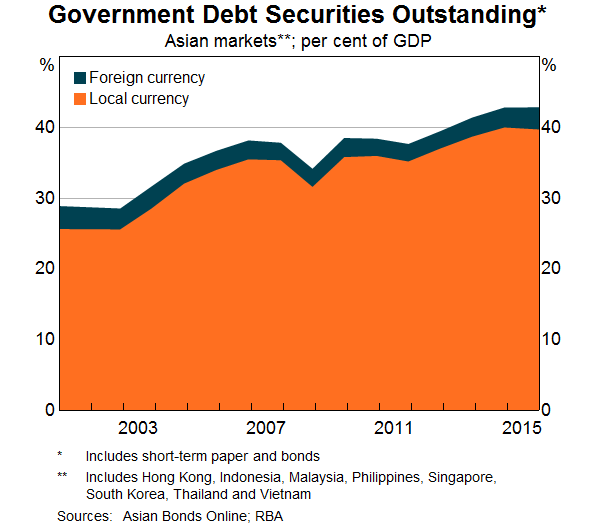
The stock of local currency bonds issued by corporates (both financials and non-financials) has also grown much faster than GDP (Graph 2). As usual, the development of local currency sovereign bond markets has helped by providing a benchmark for pricing. The stock of corporates' foreign currency bonds has grown somewhat faster than GDP since the Asian financial crisis, although the extent differs between data sources. A broader measure of their FX debt – including (cross-border) FX loans – has also grown faster than GDP but such lending did fall sharply in the years immediately after the crisis.
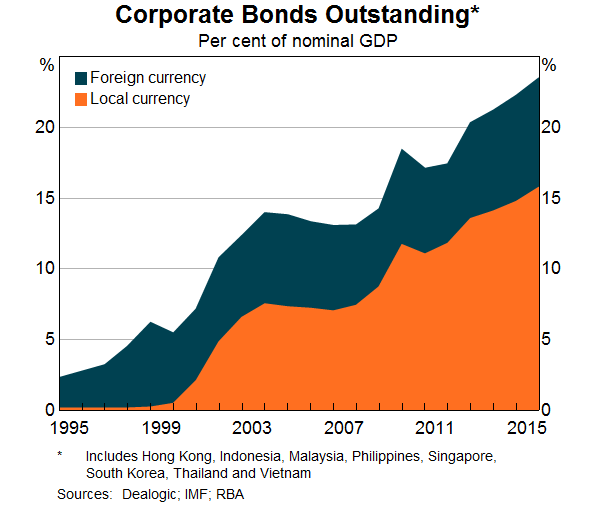
The persistence of corporate debt funding in FX, and particularly its increase in recent years, has raised new concerns about exchange rate risk.[7]
To some extent, these concerns are allayed by the existence of natural hedges, such as foreign currency export income, although rising US dollar-denominated debt servicing costs at a time of falling US dollar-denominated commodity revenues would obviously be problematic.[8]
Importantly, concerns about corporates' FX borrowing are also partly allayed by the fact that derivative hedging markets, while still relatively small and undeveloped in some countries in the region, have grown considerably since the early 2000s.
Continued foreign currency bond issuance by Asian residents and foreign participation in local currency bond markets has contributed to this growth.
Entities in smaller markets typically issue foreign currency debt in offshore bond markets because they can issue larger, lower-rated and/or longer-maturity bonds than they can (at least at comparable prices) in their domestic market. The existence of foreign entities that have a comparative advantage in issuing in the local currency of these residents, but ultimately want FX, provides a ready source of (ultimate) counterparties to these residents. As do foreign investors in local currency debt that want exposure to domestic credit and interest rates, but not exchange rates, as well as other non-residents who are willing and able to take on exchange rate risk.
The available data suggest there has been a pick-up in foreign issuance of local currency bonds in emerging Asian currencies in recent years, most notably in Chinese Renminbi (RMB). But it remains an extremely low share of (non-government) bonds outstanding, in contrast to the share for developed Asia (Graph 3; left hand side). On the other hand, there has been a trend increase in the share of emerging Asian economies' sovereign debt that is held by foreigners (right hand side). But, again, the share remains lower than for developed Asia. And liaison by the Asian Development Bank suggests that many non-resident investors in these markets do not hedge their FX risk; they want exposure to both the domestic interest rate and exchange rate.[9] Nonetheless, for emerging Asian economies there has tended to be a positive association between increased foreign holdings of local currency government debt and growth in onshore FX derivatives turnover. But, as I'll now discuss, these markets still have some way to go.
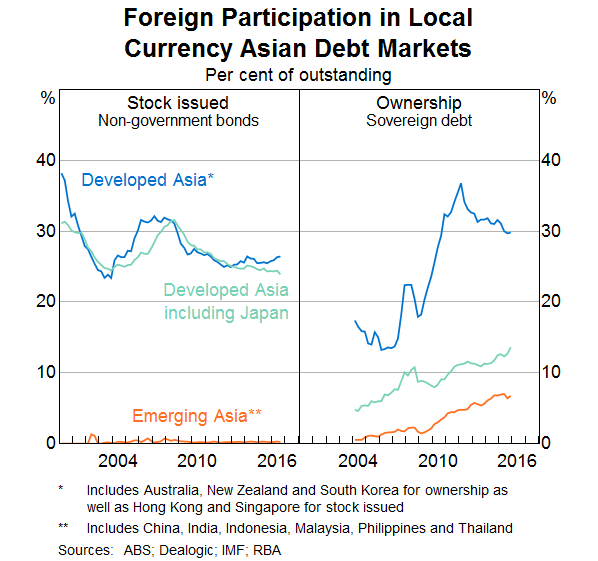
General Trends in Hedging Markets
So, what have been the recent trends in hedging markets in Asia?
In addressing this question, I will draw on preliminary results from a recent Bank for International Settlements (BIS) survey of derivative activity.[10] The survey separately identifies OTC derivatives that can be used to hedge FX risk (such as forwards, swaps and options) and OTC derivatives that can be used to hedge interest rate risk (such as single-currency fixed for floating rate swaps).
In assessing the ease with which an exposure can be hedged, ideally one would look at hedging activity in a particular location and activity for a particular currency in all locations. But data for the latter are incomplete for the smaller Asian currencies. So I will focus mostly on the former.
The extent of development in hedging markets varies significantly across Asia. A useful way to examine these differences is to group these economies into financially developed markets – some of which are financial centres, such as Hong Kong, Japan and Singapore – and emerging market Asia.[11]
Turnover in derivatives is significantly higher in the more developed Asian markets than in emerging market Asia, even when appropriately scaled.[12] This is consistent with their: stronger financial market infrastructure; higher degree of capital market openness; and the generally higher degree of foreign participation in their sovereign debt markets.
For turnover in FX derivatives, several things stand out (Graph 4): (i) activity has generally risen over the past decade even when scaled by a measure of cross-border transactions; (ii) developed Asian markets stand out as having a high degree of turnover; (iii) there was a particularly strong increase in turnover in these markets between 2013 and 2016; and (iv) FX derivatives turnover in emerging Asian economies has also increased significantly in the past few years, but remains a small part of the global market.
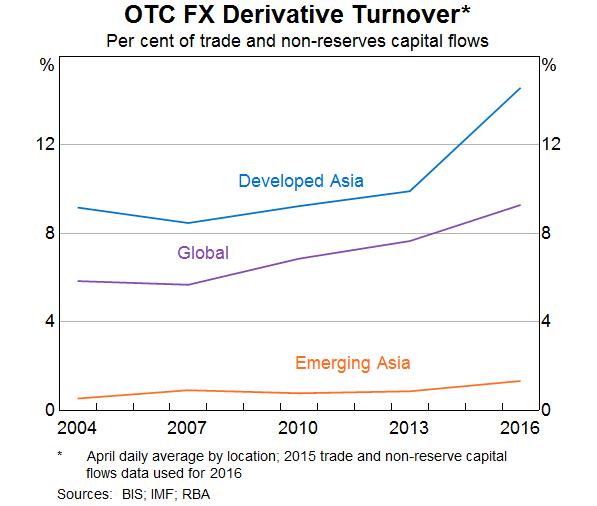
The increase in FX derivatives turnover within the developed Asian markets partly reflects a pick-up in turnover for emerging Asian currencies. For example, turnover in FX derivatives for RMB in all locations is now about double turnover in FX derivatives in all currencies in China. This looks to have been driven by growth in offshore deliverable markets rather than in the non-deliverable markets that developed in a number of economies in the 1990s and early 2000s in response to barriers to using FX derivatives markets.
Much of the turnover in interest rate derivatives also reflects hedging.
A little over half of the turnover in Asian interest rate derivatives is in OTC instruments such as fixed for floating swaps, many of which are centrally cleared (Graph 5, LHS). Turnover in OTC interest rate derivatives has grown rapidly in developed Asia but, scaled by GDP, is still below the global average. Consistent with FX, OTC interest rate derivative turnover is lower in emerging market Asia than in developed Asia. In fact, it is very small. Again, however, turnover for emerging market currencies is bigger than these data suggest. For example, total turnover in OTC interest rate derivatives for RMB is about double the turnover in OTC interest rate derivatives (in any currency) in China.
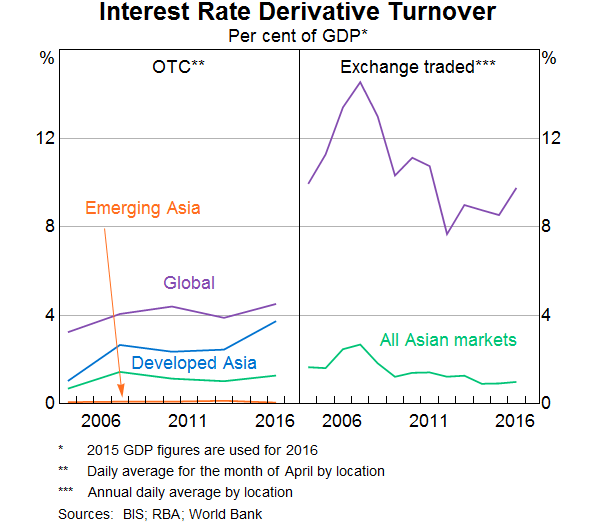
Turnover in exchange-traded instruments (right-hand side) is mostly developed market sovereign bond futures. Across Asia, exchange-traded instruments have lost market share to OTC interest rate instruments since 2010, consistent with global trends.[13]
Given that hedging markets in emerging Asian economies are still relatively underdeveloped, and the benefits to these economies of stronger and more integrated hedging markets could be substantial, it is important to think about ways to encourage growth in these markets.
One country that has been particularly active in this regard in recent years is China. Data from the BIS survey suggest that the FX derivative market in China has grown rapidly over the past few years, having doubled from 2010 to 2013 and again from 2013 in 2016, although it remains very small, even compared with other emerging economies. Turnover in the interest rate swap and bond futures markets in China has also increased rapidly from low levels over recent years.
This growth in derivatives markets has occurred alongside gradual financial reform and capital account liberalisation, including: the liberalisation of domestic interest rates; the expansion of programs that give offshore investors access to Chinese financial markets; and an increase in the flexibility of the RMB. It is interesting to note that as China lifts controls on capital outflows, and the stock of foreign assets becomes increasingly held by the private rather than official sector, the demand to hedge currency and other risks is likely to grow substantially.
What should or shouldn't be learnt from Australia's experience with financial liberalisation?
In the early 1970s, Australia's combination of a fixed exchange rate and a significant increase in capital inflows prompted the introduction of temporarily stronger controls on inflows, alongside reduced controls on outflows.[14] But these controls met with limited success. So when portfolio inflows picked up in the early 1980s, and looked as if they would rise further, the authorities floated the dollar and abolished most capital controls. Note that the Australian experience is fairly unusual: it was associated with an increase in capital inflows, not outflows.
At the time, Australians were not very well equipped to operate in a liberalised system: in addition to banks making some bad lending decisions, some Australians borrowed unhedged in what seemed at the time very cheap Swiss francs. The scale of the borrowing and the associated losses when the currency depreciated significantly were relatively small but the episode received a large amount of publicity.
Partly reflecting the high-profile nature of that event, together with agents' growing experience with a relatively volatile floating exchange rate, hedging became the norm in Australia alongside quite a rapid expansion in Australia's onshore FX derivative market. Most Australian foreign currency borrowing – of which there is a reasonable amount – is now hedged. In particular, the banks hedge nearly all their foreign currency borrowing, and on a maturity-matched basis, via derivatives.[15]
Most observers of the Australian (and others') experience with financial liberalisation have concluded that: (i) ideally, good risk management practices – including hedging – would be established before full liberalisation, so as to mitigate subsequent risks to financial stability; but (ii) it was difficult to develop such practices until entities were actually exposed to some risk; and (iii) as a result, a somewhat disruptive period of learning by your own mistakes was inevitable.
However, I would like to conclude by posing two questions:
(i) Does the concerted, global regulatory reform agenda mean that there is now more scope than in the past for sound risk management practices to be set up prior to full liberalisation?
That is, is the need for learning by your own mistakes far less than in the past?
(ii) If so, what does this imply for the pace of liberalisation for some less advanced economies in the region?
Endnotes
I am very grateful to numerous colleagues in the Reserve Bank for assistance with this speech. [*]
See, for example, Stevens G (2007), ‘The Asian Crisis: A Retrospective’, Address to The Anika Foundation Luncheon Supported by Australian Business Economists and Macquarie Bank, Sydney, 18 July. [1]
EMEAP is the Executives' Meeting of East Asia and Pacific central banks and monetary authorities. The Association of South-east Asian Nations (ASEAN) plus three (ASEAN+3) includes the 10 members of ASEAN and the People's Republic of China, Japan and South Korea. [2]
The original proposal by BCBS-IOSCO in 2013 was for FX swaps to only be exempt from initial margins. However, US regulators provided an exemption for all margin requirements on FX swaps and forwards on the basis that these instruments are short-term and their risk profile is centered on settlement risk (which is often addressed through the use of payment-versus-payment settlement arrangements). Other regulators have since followed in this direction. And non-deliverable forwards are not exempt from margining. [3]
Edey M (2015), ‘The Transition to Central Clearing of OTC Derivatives in Australia’, Speech at the International Swaps and Derivatives Association's 2015 Annual Australia Conference, Sydney, 22 October. [4]
For more details on OTC derivatives reform information, see Financial Stability Board (2016), ‘OTC Derivatives Market Reforms’, available at <http://www.fsb.org/wp-content/uploads/OTC-Derivatives-Market-Reforms-Eleventh-Progress-Report.pdf>, Eleventh Progress Report on Implementation, August. [5]
As reported by Risk.net, available at <http://www.risk.net/risk-magazine/feature/2471922/margin-rules-lead-to-ndf-clearing-surge>, in late September 2016, ForexClear, an LCH.Clearnet Limited clearing house, has had a significant increase in non-deliverable forward trades that are cleared, from about US$4 billion per day earlier in the year to around US$22–24 billion per day in recent weeks. [6]
See, for example, IMF (International Monetary Fund) (2015), ‘Global Financial Stability Report – Vulnerabilities, Legacies, and Policy Challenges: Risks Rotating to Emerging Markets’, available at <http://www.imf.org/external/pubs/ft/gfsr/2015/02/pdf/c3_v2.pdf>, October, World Economic and Financial Surveys, Washington DC. [7]
See, for example, Kofanova S, A Walker and E Hatzvi (2015), ‘US Dollar Debt of Emerging Market Firms’, RBA Bulletin, December, pp 59–69 and Windsor C (2016), ‘Currency Risk at Emerging Market Firms’, RBA Bulletin, June, pp 49–57. For a discussion of maturity-mismatch, rollover and speculative risks see Acharya V, SG Cecchetti, J De Gregorio, S Kalemli-Özcan, PR Lane and U Panizza (2015), ‘Corporate Debt in Emerging Economies: A Threat to Financial Stability?’, available at <https://www.brookings.edu/wp-content/uploads/2016/07/CIEPR2015toWeb.pdf>, Report by the Committee on International Economic Policy and Reform, Brookings Institution and Centre for International Governance Innovation, Washington DC and McCauley R, P McGuire and V Sushko (2015), ‘Dollar Credit to Emerging Market Economies’, available at <http://www.bis.org/publ/qtrpdf/r_qt1512e.htm>, BIS Quarterly Review, December, pp 27–41. [8]
Asian Development Bank (2015), ‘Facilitating Foreign Exchange Risk Management for Bond Investors in ASEAN+3’, available at <https://www.adb.org/sites/default/files/publication/173014/facilitating-fx-risk-management-asean3.pdf>, Report, August. [9]
The 2016 BIS Triennial Central Bank Survey of Foreign Exchange and OTC Derivatives Markets Activity was undertaken in two parts: the turnover portion measured activity in FX and OTC single-currency interest rate derivatives markets in the month of April, while the outstandings portion – not yet available – measured the amount of OTC derivatives outstanding as at the end of June. The results for turnover can be found here: <http://www.bis.org/publ/rpfx16.htm>. This speech also draws on the BIS Exchange-traded Derivative Statistics for interest rate derivatives. Disaggregated data on other hedging instruments are more difficult to obtain. In some cases, such as credit default swaps, this appears to reflect the small size of the market in emerging Asian economies (though trading in credit default swaps began in China last week). [10]
Except where noted, developed Asian economies are Australia, Hong Kong, Japan, New Zealand, Singapore and South Korea, while emerging Asian economies are China, India, Indonesia, Malaysia, Philippines, Taiwan and Thailand. [11]
It is likely that this would be true for exchange-traded derivatives also, with most of these derivatives being developed Asian bond futures, though data limitations prevent this breakdown. [12]
The moderation in exchange-traded interest rate turnover globally is partly explained by a decline in activity in short-term instruments – which trade predominately in exchange-traded markets – due to the sustained period of low and stable policy rates (particularly for the Japanese yen). Activity in longer-dated instruments – most of which trade in OTC markets – has been less affected by the period of low rates. [13]
A fuller discussion of Australia's experience with capital account liberalisation can be found in Debelle G and M Plumb (2006), ‘The Evolution of Exchange Rate Policy and Capital Controls in Australia’, available at <http://www.mitpressjournals.org/doi/pdf/10.1162/asep.2006.5.2.7>, Asian Economic Papers, 5(2), pp 7–29. [14]
Rush A, Sadeghian D and M Wright (2013), ‘Foreign Currency Exposure and Hedging in Australia’, RBA Bulletin, December, pp 49–58. [15]
